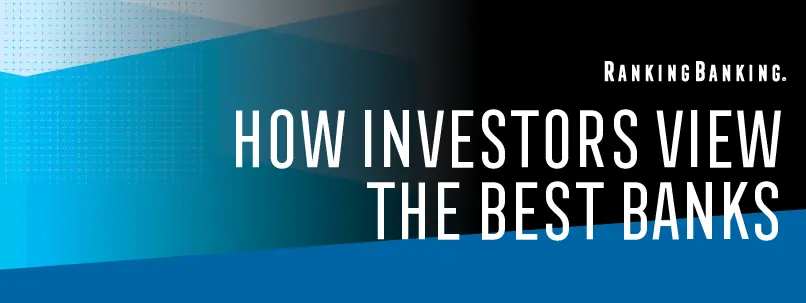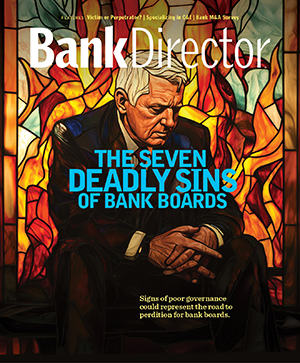Emily McCormick is Vice President of Editorial & Research for Bank Director. Emily oversees research projects, from in-depth reports to Bank Director’s annual surveys on M&A, risk, compensation, governance and technology. She also manages content for the Bank Services Program, including Bank Director’s Online Training Series. In addition to speaking and moderating discussions at Bank Director’s in-person and virtual events, Emily writes and edits for Bank Director magazine, BankDirector.com and Bank Director’s weekly newsletter, The Slant. She started her career in the circulation department at the Knoxville News-Sentinel and graduated summa cum laude from The University of Tennessee with a bachelor’s degree in Spanish and International Business.

How Investors View the Best Banks
It wasn’t too long ago that investors and analysts thought East West Bancorp had too much capital, says Irene Oh, chief financial officer at the Pasadena, California-based bank. Why didn’t East West use that money to buy back shares? While the bank executed some “modest” buybacks, management didn’t want to dip capital to a level it deemed imprudent — that wouldn’t serve shareholders’ long-term interests. “A bank is a leveraged company. It’s a leveraged, balance sheet business, and the actual capital that you have matters,” she explains. “The bank management team needs to manage the bank, regardless of what … investors say.”
With a tangible common equity ratio of 8.67% at the end of 2022, East West’s capital levels don’t look excessively high. But the bank, with $64 billion in assets at year end, had the highest TCE ratio among banks above $50 billion in assets in Bank Director’s RankingBanking analysis. The median for this group of big banks was 5.85%, and 7.62% for all banks in the study, which ranks the performance of the 300 largest publicly traded banks by rating profitability, asset quality, total shareholder return and capital adequacy for 2022.
Lately, Wall Street hasn’t treated banks well — including the industry’s top performers. The top 25 RankingBanking banks overall, which include East West, reported a median return on average equity of 16.36%. Asset quality remained pristine. But these top performers had a total shareholder return for 2022 of just 6.5%, compared to 36.31% for 2021. Overall, the 300 examined banks had a median return of -5.9%. The biggest banks fared the worst, with a median TSR of -19.0%.
Rising rates pressured bank stocks last year. As of mid-2023, the market has been even harder for regional banks, including those that traditionally performed well in Bank Director’s RankingBanking analysis — Western Alliance Bancorp. and East West. “Last year, bank stocks, as measured by the Nasdaq bank index, were down 18%,” says Mark Fitzgibbon, managing director and head of financial services research at Piper Sandler & Co. “Five months into the year, we’re down 33%.” Investors have doubts about an industry characterized by three recent — and sizable — bank failures, along with an uncertain credit outlook as the Federal Reserve continues to fight inflation by raising interest rates.
The Bancorp, with $8 billion in assets, has been one of the exceptions to the recent carnage in bank stock prices. Year-to-date, its stock price increased 38% through July 26, 2023. The Wilmington, Delaware-based bank leverages a unique model focused on payments and a banking as a service platform. It ranked No. 16 overall in Bank Director’s analysis.
Christopher Marinac, director of research at Janney Montgomery Scott, says investors like The Bancorp’s above-average growth. “Banks are not necessarily growth vehicles, but when you have a company that is doing better than many other peers, there are investors who gravitate to that because of [the] growth rate,” explains Marinac.
Frank Schiraldi, managing director and senior research analyst at Piper Sandler, adds that deposit outflows haven’t been strong at The Bancorp, and its net interest margin expanded from 3.35% for 2021 to 3.55% for 2022; it reported a net interest margin of 4.67% for the first quarter 2023. Unlike banks such as SVB that saw long-term bonds go under water as rates rose, short-term, floating rate loans on The Bancorp’s balance sheet have allowed it to adjust to changes in the interest rate environment. Read more about this strategy in How the Best Banks Manage the Balance Sheet.
The Bancorp has taken a unique approach to banking. But for most financial institutions, Fitzgibbon sees two characteristics that investors value today: historically good asset quality and high capital ratios. “Companies with tons and tons of excess capital,” says Fitzgibbon, “even if they make a few mistakes, they’re going to be OK, and they’re going to have capital to take advantage of the more difficult environment. So, when other banks are pulling back, they’ll be able to go and make loans at much wider spreads.”
Raleigh, North Carolina-based First Citizens BancShares, which acquired Silicon Valley Bank from the Federal Deposit Insurance Corp., has proven to be another exception to the downturn in bank stocks in 2023. While it had a -8.4% TSR for 2022, its stock rose when it acquired SVB from the Federal Deposit Insurance Corp. on March 27, and was up 88% for the year, as of July 26. It ranked second for capital adequacy in its peer group of big banks in our analysis, with a TCE ratio of 7.62%. Overall, the now $215 billion bank ranked 23rd among the largest banks.
But for many banks, “investor sentiment’s pretty tough right now,” says Christopher McGratty, head of U.S. bank research at Keefe Bruyette & Woods. With its stock price down 5% for the year as of July 26, East West has performed slightly better than the KBW Nasdaq Regional Banking Index. In contrast, the S&P 500 was up 19% over the same period.
The bank’s fundamentals appear sound. “They’ve got a great balance sheet. They’ve got very good earnings power, and the valuation is very reasonable,” he says. McGratty cites East West’s track record for risk-adjusted growth, along with its capital levels. “We still think [the stock is] pretty inexpensive.”
East West’s capital buffer should position it to grow in an adverse environment, even if it doesn’t buy another bank. “Second to Wells Fargo [& Co.], we are now the largest bank [based] in California,” says Oh. “There are going to be opportunities to grow organically in California.” East West differentiates itself by serving Asian-American customers and businesses. Unlike Santa Clara, California-based SVB — which failed when its highly concentrated client base pulled billions in deposits out of the bank — East West’s customers represent a broad base of deposit relationships, as well as commercial real estate, single family, and commercial and industrial (C&I) loans. Overall, East West ranked first among banks over $50 billion and rounded out the top 25 in the RankingBanking study.
For Dory Wiley, CEO of Commerce Street Holdings, capital is king. “I like 8% to 10% capital,” he says. “If you’re a conservative bank, play safe. Safe means capital.” And it means a competitive opportunity in a downturn. A bank with lower capital levels can’t be opportunistic — and could struggle if problems come its way.
Wiley personally invested in SVB Financial Group, the holding company for Silicon Valley Bank, but sold his stake a couple of years ago, citing the risk management failures that brought about the bank run that resulted in SVB’s demise. “I had no idea they were gonna fail, but they started to get too leveraged, too much liquidity [and were] putting bonds to work at really low prices. And they didn’t have enough holding company capital.” He also earlier exited his position in Signature Bank, another March failure. Wiley says he encouraged that bank to raise more capital, telling them, “‘You guys are growing; you’re doing terrific. But you need more capital in case something goes wrong, or these crypto deposits leave.’”
Fitzgibbon says investors now prefer what he calls “bunker banks,” featuring a strong capital position, liquidity and credit quality. “They’re investing in companies that can withstand a potentially large storm that’s bearing down on the industry,” he says. “[Investors] care about survivability.”
In addition to capital, Wiley favors banks with a strong core deposit franchise. He also likes growing banks with solid credit underwriting and an appropriate level of loan loss reserves — that number will depend on the bank, but should be at least “north of 1%,” he says. A track record for thriving through adverse economic cycles doesn’t hurt. He’s also looking at metrics that describe the balance sheet, such as the loan-to-deposit ratio, and he wants to understand a bank’s exposure to commercial real estate. He loves to talk to a bank’s chief lending officer or chief credit officer to understand what’s going on behind the metrics. “They don’t play poker,” says Wiley.
Investors have been closely watching statements made by bank CEOs in the wake of the failures of SVB, Signature and First Republic Bank.
“It is more important than ever to have a proactive communication stream,” says Patrick Vernon, senior manager, advisory services at Crowe LLP. That requires an appropriate level of transparency on the part of banks. “Providing that level of comfort if a major event happens, why it’s happening, what [you’re] planning to do about it, and how everyone can be at ease — because if you don’t take that proactive approach, that’s when things spiral out of control, and you’re on the defensive.”
Crowe Partner Kara Baldwin adds that investor decks and earnings releases should be adapted to reflect what investors care about at that moment.
East West’s management team is well known to investors — CEO and Chairman Dominic Ng has led the bank since 1991; Oh became CFO in 2010, six years after joining East West. She’s seen an uptick in questions lately from investors and analysts, which she views as an opportunity. “Especially with this uncertainty about if and when there’ll be a recession,” she says, answering those questions “gives people comfort as well, to understand what we’re seeing in the portfolio, why we’re comfortable and what are the actions that we’re taking separate from what happened in March.”
Executives should continue to get in front of investors through roadshows and conferences, says Schiraldi, but he cautions against too much communication. “Some of the banks that have been beaten up the most have had to respond on almost a weekly basis to the market. I don’t think you want to be out there having to defend the story constantly.”
But in some ways, the fundamentals of bank investing have changed. In May, The Wall Street Journal published an article equating bank stocks to so-called meme stocks like GameStop Corp., the video game retailer that saw its stock rise and fall based on social media buzz.
“I came to kill the banks,” wrote one short seller, 30-year-old pub owner Daniel Betancourt, on the messaging platform Discord.
Tom Brown, the CEO of hedge fund Second Curve Capital, says there’s been a significant increase in short selling activity in bank stocks. Many long-term investors appear to be missing in action.
“The stock price volatility has been so extreme,” says Oh, noting the dip East West’s stock took following SVB’s failure. Oh takes a long-term view. “We need to make sure that we continue to have the financial performance, from an earnings perspective, from a capital generation perspective, from a credit quality perspective,” she says. “And I am confident over time, [when] there’s distance and more clarity about things, that stocks will come back, for us and for the sector.”
Of course, banks are particularly vulnerable to economic cycles. “If you look at the long-term
performance of banks, [they’re] not outperforming the market, and it tends to be flat,” says Marinac. “It’s good for a little bit, then it’s bad, then sometimes it’s really bad. And then it’s good again, and then it’s really good, and then it’s just OK.”
He believes the industry doesn’t get enough credit from the market for bringing down expenses over the years. “Overhead continues to be, in my opinion, a missed point by investors,” Marinac says. He also points to pre-provision net revenue as an important factor to monitor, helping an institution grow the reserves it needs to fight troubled assets. “The more cash flow a bank has, the more provisions it can expense, the more it can fight the fire,” he says.
Both Wiley and Brown have been active bank investors for decades. They’re familiar with the cyclicality of the industry and seek strong, undervalued performers that are more likely to improve over the long term.
An optimistic Brown believes banks are set to experience the next big bull market, pointing to two others he’s experienced in his career. The first kicked off in 1989, when Warren Buffett’s Berkshire Hathaway bought a stake in Wells Fargo. The other began on March 9, 2009, he says, following the financial crisis of 2007-08. “Both bull markets lasted nine years long, and we’re getting set for the next one,” says Brown. Why? Because many banks remain profitable, safe and sound companies. And the next downturn will bear that out.
“Margins are going to be under more pressure. The loan growth has slowed sharply; asset quality is going to deteriorate. … who would want to buy a bank’s stock in the face of those things?” says Brown. “The valuation comes down until somebody says, ‘OK, I’ve seen this before. They’re gonna work their way through this.’”
And when the going gets tough, the best banks will prove just how strong they are.
Click here to access the complete RankingBanking study.



